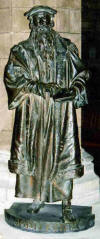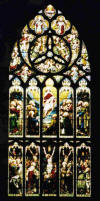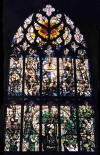|
Edinburgh
The Castle
|

The Great Hall, formerly
the castle's banquet hall
Basket-hilt swords
and battle axes
 |
 
 
Clockwise from top left :
(1) western defenses
and new barracks
(2) the castle from Johnstone Terrace
(3) the castle
entrance
(4) esplanade to the castle entrance |

Scottish Monarchs
and Coats of Arms
The Reformers
and Coats of Arms

|
|
This ancient fortress stands as a sentinel, guarding the city and
giving silent witness to the tragedies and triumphs, the drama and intrigue, and
the poverty and riches of centuries of Scottish history. One pair of stained
glass windows in the Great Hall bears the names and coats of arms of Robert the
Bruce and other Scottish monarchs. In another are Scottish
reformers, most of whom were martyred for the faith.
The
high basalt rock upon which the castle stands was the site of a Bronze Age hill
fort. During the Roman occupation, it was a thriving settlement. By the eleventh
century, it was firmly established as a principal Scottish royal residence. The
earliest surviving part of the castle was built in the same century by David I.
During its 1,000-year history, the castle has been attacked, damaged, and rebuilt a
number of times. In the sixteenth century, Oliver Cromwell established a
permanent military base on the grounds; he, who despised the religious passions
of the Reformers, also cared nothing for the aesthetic and historic features of
Edinburgh Castle. His army destroyed and erected buildings at the castle in a
manner which evidenced this disregard, creating something of a conglomeration.
In the
nineteenth century, fortunately, the re-emergence of a Scottish national
identity led to a change in emphasis at Edinburgh Castle. Sir Walter Scott
applied for and was granted permission to look for the Scottish Honours ~ the
sixteenth century Scottish Crown regalia consisting of a crown, scepter, and
sword ~ which had been missing since about
1707. He discovered them in the castle, exactly where they had been hidden
over a century earlier. They were placed on display, and the Great Hall
subsequently was restored. In 1923, the Scottish National War Memorial was
built, and the main garrison of the British army left the castle. Finally,
in 1996, Scotland's Stone of Destiny was returned to Edinburgh Castle from
Westminster Abbey, to which it had been "exiled" seven hundred years earlier. A
plain slab of sandstone, the Stone reputedly is the seat on which the ancient
Scottish kings were crowned. Today, the Stone of Destiny and the Honours
of Scotland are on display in the Crown Room of Edinburgh Castle.
Photographs are not permitted.
There was so much more of the castle to enjoy, but we
were spending only a day in Edinburgh and had yet to see St. Giles and
Greyfriars.
St. Giles Cathedral
| |
|


|
  
  
|
|
|
While a parish church
has been in Edinburgh since about 854 A.D., St. Giles Kirk was built in the 12th
century. A 1385 fire destroyed most of the structure, with four massive
pillars in the center of the building possibly being all that survived.
Rebuilding began and continued almost unabated until the early 16th century.
In the 17th century, St. Giles was declared a cathedral by Charles I and again by
Charles II, a status it lost when Presbyterians gained control of the church,
though the name is in use today. St. Giles
is generally considered the mother church of Presbyterianism.
During the Reformation, many changes were made to the interior
- some publicly
and some in secret - owing to significant differences in doctrine. One
example is that Presbyterians hold that all believers are saints, meaning set aside for
God's holy purposes, and that no saint is able to grant favor with or access to
God. For that reason apparently, a statue of the venerated St. Giles was removed in the night by a person or
persons unknown and has never been recovered. It seems ironic that there
stands in the church today a statue of John Knox, the reformer whose work gave
birth to the Presbyterian Church. The difference, however, is that neither Knox
nor any other reformer was venerated, nor were any regarded as holding an elevated status
before God. (The statue standing outside St. Giles is of the Fifth Duke of Buccleuch.)
John Knox preached his first sermon at St. Giles on 1 July 1559.
He was described by his clerk, John Bannatyne, as "the light of Scotland, the
comfort of the Church ..., the mirror of godliness, a
pattern and example to all true ministers, in purity of life, soundness of
doctrine, and boldness in reproving of wickedness; one that cared not for the favour
of men, how great soever they were." A less partial man, Principal Smeton, also spoke of Knox in glowing terms: "I know not if ever so much piety and
genius were lodged in such a frail and weak body. Certain I am, that it will be
difficult to find one in whom the gifts of the Holy Spirit shone so bright, to
the comfort of the Church of Scotland. None spared himself less in enduring
fatigues, bodily and mental; none was more intent on discharging the duties of
the province assigned to him. ... Released from a body exhausted in Christian
warfare, and translated to a blessed rest, where he has obtained the sweet
reward of his labours, he now triumphs with Christ."
Another prominent name associated with St. Giles is
that of Archibald Campbell (1607-1672), First Marquess and Eighth Earl of
Argyll. When religious principle came into
question, titles, lands, and power meant nothing to him. Firmly believing
that Christ, and not the king, was sovereign over the church, he signed
Scotland's 1638 "National Covenant," a response to King Charles I's attempts to
rule the church in Scotland. The Covenant emphasized Scotland's loyalty to the
king, insofar as the king did not infringe upon religious faith and freedom, and
it declared that any attempt to move the church toward Catholicism would be rejected. Campbell
was eventually left both
penniless and powerless, and he was charged with conspiracy in
the murder of Charles I because he had worked for a time with the Cromwellian government.
Since Cromwell had orchestrated Charles's death, Campbell was declared guilty of the conspiracy as well. When a sentence of death was pronounced and
his wife cried out, "The Lord will pay them back for this!" he quietly
admonished her: "Control yourself, Dear. Truly, I pity them. They don't know
what they are doing; they may shut me in where they please, but they cannot shut
God out from me. For my part, I am as content to be here as in the castle, and
as content in the castle as in the Tower of London, and as content there as when
at liberty, and I hope to be as content on the scaffold as any of them all." Archibald Campbell, Covenanter, stood on the scaffold on 27 May 1661 and spoke
calmly to those around him. A physician checked his pulse and found it steady. And then, he was beheaded.
The monument to his memory, above, was later placed in St.
Giles. On it are inscribed these words: "I set the Crown on the King's
Head. He hastens me [by execution] to a better Crown than his own."
While Campbell was memorialized at St. Giles, it
was in the kirkyard of another, more modest kirk that the Covenant had been
signed. A walk of a few blocks brought us to ...
Greyfriars Kirk
|
|
|


 |
The first church built in Edinburgh after the Reformation,
Greyfriars opened in 1620. In 1638, the first National Covenant was publicly read and signed in
its kirkyard. King Charles I wished to rule not only Scotland
but also, through bishops whom he had appointed, the church. He
required that all kirks follow the English Prayer Book in worship.
The Covenant, co-authored by Archibald Johnston of Warriston and Alexander Henderson, emphasized loyalty to the king but demanded religious freedom. |
The Covenant was signed immediately
by leading individuals such as Archibald Campbell, whose memorial was
built in St. Giles, and the following day by
the clergy and burgesses of Edinburgh. Afterward, copies were circulated
throughout Scotland, and 300,000 believers eventually signed the historic
document. Lord Cromwell, who at first had pretended to sympathize
with the Covenanters, later viciously opposed them. He placed his army in
Greyfriars Kirkyard and made it a prison. In 1679, about 1,200
Covenanters were confined in the open air and given only water and four
ounces of bread each day. Many died while others were either
executed, sent abroad as slaves, or eventually freed upon signing oaths of
allegiance. Over the course of the century-long Presbyterian
struggle, some 30,000 Scots died for their faith.
Contemplating
the persecution and suffering of thousands who did nothing worse than
resolutely hold to their faith, I thought how easily I sometimes grumble
over the smallest inconveniences of life. I left Greyfriars with no small amount of reflection,
and we drove
north of Edinburgh to have dinner at a different kind of historic spot.
Queensferry
Hawes Inn on the Forth River
At Queensferry, the
Forth River flows into the Firth of Forth, dividing South Queensferry
from the town proper. Facing the river is Hawes Inn, a favorite
haunt of author Robert
Louis Stevenson (1850-1894). Stevenson stayed often in room 13
and, according to local tradition, planted the yew tree that still
grows on the grounds. He spent long hours at a desk at the window, where he watched the great
sailing ships come in from the sea. There, inspired by the scene before him, he wrote a major portion of
his novel "Kidnapped". Stevenson was also the author of "Treasure Island", "Dr. Jekyll and Mr.
Hyde", and other works.)
The host at Hawes Inn was very gracious, showing us around
and apologizing that we could not visit room 13 as it was then
occupied. Our waiter was very cordial, and the food was
delicious. We thoroughly enjoyed our time at the Inn and would
gladly return.
__________________________________________________________________________________________________
If you came from the Bed and Breakfasts page,
use your
browser's back button to return to that page.
If you came from a search, click here to begin at the
beginning:
Home
Contact
Copyright 2018 · Loretta Lynn Layman · The House of
Lynn |






















